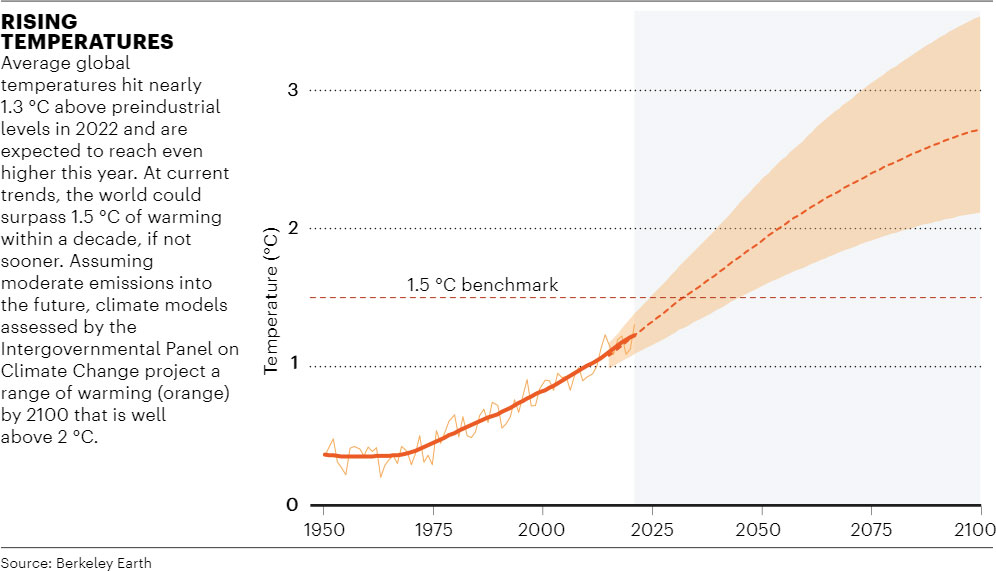Critical climate threshold likely briefly breached
On Friday and Saturday, the 17th and 18th of November 2023 global surface temperature likely breached for the first time the 2°C temperature target, when compared with preindustrial levels.
Provisional ERA5 global temperature for 17th November from @CopernicusECMWF was 1.17°C above 1991-2020 – the warmest on record.
Our best estimate is that this was the first day when global temperature was more than 2°C above 1850-1900 (or pre-industrial) levels, at 2.06°C. pic.twitter.com/jXF8oRZeip
— Dr Sam Burgess 🌍🌡🛰 (@OceanTerra) November 19, 2023
Final numbers out from @CopernicusECMWF for the 17 Nov temperature anomaly at
2.07°C above preindustrial and
Provisional data for 18th Nov at
2.06°C above preindustrial
Now two Nov 2023 days where global temperature exceeded 2°C in ERA5
💙💙🩵💙🩵🤍🧡❤️❤️❤️💔#COP28 https://t.co/Cc0PK3K9FW
— Dr Sam Burgess 🌍🌡🛰 (@OceanTerra) November 20, 2023
And ..
🌡️ ERA5 data from @CopernicusECMWF indicates that 17 November was the first day that the global temperature exceeded 2°C above pre-industrial levels, reaching 2.07°C above the 1850-1900 average and the provisional ERA5 value for 18 November is 2.06°C. pic.twitter.com/lLGwlCsZtP
— Copernicus ECMWF (@CopernicusECMWF) November 20, 2023
Andrew Freedman from Axios points out ..
Why it matters: A daily global average surface temperature climb to greater than 2°C above preindustrial levels indicates just how quickly the planet is warming, including some of the extremes that are now possible.
Yes, but: Breaching the 2-degree threshold for two days does not mean that the Paris Agreement’s target of holding global warming to “well below” such a mark has been exceeded.
- The agreement refers to the long-term average over two or more decades rather than one day, month or even year.
Between the lines: The dataset that shows the record, known as ERA5, comes from a process known as reanalysis, in which a computer model uses surface temperature readings from land and ocean sources as well as algorithms to arrive in near time at an accurate global temperature reading for each day.
-
The new record is considered provisional since it is subject to adjustment for accuracy. Subsequent information from other reanalysis sources and surface-based data sets and other reanalysis methods may confirm it or diverge slightly.
Some context ..

The big picture: News of the record is in keeping with the record-shattering year so far.
- This year is on track to be the hottest on record globally in all surface weather datasets and saw both the hottest month on record (September) but also the largest margin for any monthly record in history.
- Each month since May has set monthly global temperature records, and heat waves have scorched large parts of the globe, from the Southern U.S. to Africa, South America, China and Japan.
- Last summer, the global average surface temperature first rose into record territory and eclipsed the 1.5-degree Paris target. That caught some scientists off guard, and the failure of the planet to cool back down below all-time record territory has stood out.
- November, too, is now likely to be the hottest such month on record.
The intrigue: The 1.5 and 2-degree targets were set by political leaders, but scientific research bolsters the case that if warming were to exceed even the more stringent target, the likelihood of devastating and potentially irreversible climate calamities would increase dramatically.
- A report released last week shows the ways that climate change is already wreaking havoc on the U.S., for example.
- While human-caused climate change is viewed as the larger driver of the long-term increase in temperatures and record warmth this year, a strong El Niño event in the tropical Pacific Ocean is helping to pump added heat into the climate system.
- This is further increasing temperatures, easily vaulting them into record territory.
What’s next: This record, like some others so far this year, is likely to be cited in the fraught negotiations at the COP28 climate summit in Dubai, which begins Nov. 30.
Go deeper… Climate change report: Heat-related deaths on track to rise 370% by mid-century
Related
Is it too late to keep global warming below 1.5 °C?The challenge in 7 charts https://www.nature.com/immersive/d41586-023-03601-6/index.html
About the Author: CLIMATE STATE
POPULAR
COMMENTS
- Robert Schreib on Electricity generation prices may increase by as much as 50% if only based on coal and gas
- Robert Schreib on China made a historic commitment to reduce its emissions of greenhouse gases
- Lee Nikki on COP30: Climate Summit 2025 – Intro Climate Action Event
- Hollie Bailey on Leaders doubled down on fossil fuels after promising to reduce climate pollution
- Malcolm R Forster on Mythbusters tests global warming theory – does CO2 warm air?